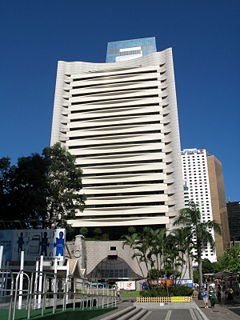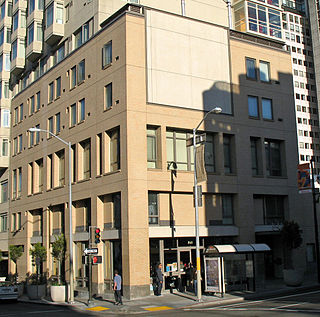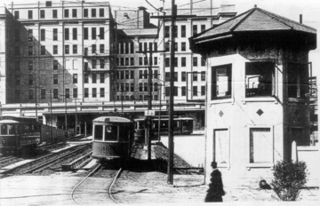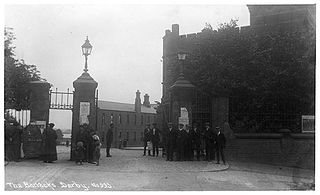 W
WThe Anchor Brewery was a brewery in Park Street, Southwark, London, England. Established in 1616, by the early nineteenth century it was the largest brewery in the world. From 1781 it was operated by Barclay Perkins & Co, who in 1955 merged with the Courage Brewery, which already owned the nearby Anchor Brewhouse. The Park Street brewery was demolished in 1981.
 W
WThe Emory Bannister House was a historic house at 3 Harvard Street in Worcester, Massachusetts. Built in 1847, this Greek Revival house was an early design of Worcester architect Elbridge Boyden, and one of the city's few houses of the period with an identified architect. The house was listed on the National Register of Historic Places in 1980. It was demolished in 1981; its site is now a parking lot.
 W
WThe Benjamin Barker House was a historic house on Main Road in Tiverton, Rhode Island. Built c. 1850, it was a two-story wood frame structure with an impressive Greek Temple front, with full-height fluted Ionic columns supporting a full triangular pediment. The pediment had an astylistic triple window in it. The roof was topped by an octagonal cupola with belvedere, with two narrow chimneys piercing the ridge line. It is possible the house was designed by Russell Warren, who is documented to have designed a number of other high-style Greek Revival houses in the region. The purchaser is believed to be Benjamin Barker, a lumber merchant operating in nearby Fall River, Massachusetts.
 W
W83–85 Sigourney Street in Hartford, Connecticut was an Italianate style double brick house. Built in 1865, it was the oldest surviving residential building on the southern part of Sigourney Street in the city's Asylum Hill neighborhood. It was listed on the National Register of Historic Places in 1979, at a time when there were no known threats to the building. A modern building, housing the former Connecticut Culinary Institute, was built on the site in 1981 and now stands at 85 Sigourney Street; it is the Hartford campus of the Lincoln Culinary Institute, and is part of the Lincoln Group of Schools.
 W
WThe Alexander Young Building was a building in Honolulu, Hawaii built during 1900-1903 by Alexander Young (1833–1910), a Honolulu mechanical engineer and businessman from Scotland.
 W
WEdwin Gilbert Cooley Vocational High School was a public 4–year vocational high school and middle school located in the Old Town neighborhood on the Near North Side of Chicago, Illinois, United States.
 W
WDenham Film Studios was a British film production studio operating from 1936 to 1952, founded by Alexander Korda.
 W
WThe Flixborough disaster was an explosion at a chemical plant close to the village of Flixborough, North Lincolnshire, England on Saturday, 1 June 1974. It killed 28 people and seriously injured 36 out of a total of 72 people on site at the time. The casualty figures could have been much higher if the explosion had occurred on a weekday, when the main office area would have been occupied. A contemporary campaigner on process safety wrote "the shock waves rattled the confidence of every chemical engineer in the country".
 W
WThe Greene Inn was a historic summer resort hotel at 175 Ocean Road in Narragansett, Rhode Island.
 W
WThe Hippodrome Theater was located at 720 Euclid Ave in Cleveland, Ohio. In its day, it was a very lavish theater and ranked as one of the world's greatest playhouses. Performers appearing at the Hipprodome included Enrico Caruso, Sarah Bernhardt, W. C. Fields, Will Rogers, Al Jolson, and John McCormack. The auditorium had two balconies and seating for 3,548.
 W
WThe Hong Kong Club Building is a 25-story office building located in between Chater Road and Connaught Road Central at the junction of Jackson Road, in Central, Hong Kong. The Hong Kong Club Building is currently in its third generation, in its second location. It is owned by the Hong Kong Club, which occupies 8 levels, while the other floors are leased for office use.
 W
WThe Independence Building was a 186 feet skyscraper in Charlotte, Mecklenburg County, North Carolina, United States. It was built in 1909 by J.A. Jones Construction and imploded on September 27, 1981 to make way for 101 Independence Center. It originally had 12 floors but 2 more were added in 1928. It was the tallest commercial building in North Carolina, overtaking the title previously held by the Masonic Temple Building in Raleigh. The height of the Independence Building was surpassed by the Jefferson Standard Building in Greensboro in 1923.
 W
WThe International Hotel, often referred to locally as the I-Hotel, was a low-income single-room-occupancy residential hotel in San Francisco, California's Manilatown. It was home to many Asian Americans, specifically a large Filipino American population. Around 1954, the I-Hotel also famously housed in its basement Enrico Banduccci's original "hungry i" nightclub. During the late 60s, real estate corporations proposed plans to demolish the hotel, which would necessitate displacing all of the I-Hotel's elderly tenants.
 W
WThe Joyner Building was a historic classroom/administration building located on the campus of Western Carolina University in Cullowhee, Jackson County, North Carolina. brick Colonial It was built in 1913-1914, and was a two-story on a raised basement, "T"-shaped red brick building with a cross-gab1e-on-hip roof. The main block was 11 bays wide and six bays deep.
 W
WKarenkō Shrine was a Shinto shrine located in Hualien City, Hualien County in Taiwan during Japanese colonial rule. It was ranked as a Prefectural Shrine and was the central shrine in Karenkō Prefecture.
 W
WLord Simcoe Hotel was one of many now vanished hotels in Toronto, Ontario, Canada. Built in 1956, the 20-storey concrete and glass modernist structure was designed by Henry T. Langston and Peter Dickinson. The hotel was named for John Graves Simcoe, Lieutenant Governor of Upper Canada and a resident of York, Upper Canada. The name was somewhat incorrect as Simcoe was never called himself a Lord.
 W
WThe Public Service Terminal was a three-level streetcar station in Newark, New Jersey, owned and operated by the Public Service Corporation, adjacent to the Hudson and Manhattan Railroad's Park Place station. It served as the terminus for streetcar lines from as far as Trenton. Public Service was both a transportation company and a utility, providing electric and gas service to much of northern New Jersey. The six office stories above the terminal served as company headquarters.
 W
WNormanton Barracks was a military installation in Normanton, Derby, England.
 W
WThe Pabst Building was a 14-story neo-gothic high-rise building in Milwaukee, Wisconsin. Built in 1891, it was Milwaukee's first skyscraper, and was the tallest building in Milwaukee until the Milwaukee City Hall was finished four years later. The Pabst Building was demolished in 1981 and the 100 East Wisconsin Building now occupies its site. Having stood at 235-foot (72 m) tall, the Pabst Building is the 2nd tallest building ever demolished in Wisconsin.
 W
WThe Paris Theatre was a cinema and theatre located on the corner of Wentworth Avenue and Liverpool Street in Sydney that showed films and vaudeville, cabaret and plays. The theatre changed names several times, trading as Australia Picture Palace (1915-1935), Tatler Theatre (1935-1950), Park Theatre (1952-1954) and Paris Theatre (1954-1981) before being demolished in 1981. In May 1978 the theatre hosted a film festival that inspired the first Sydney Gay Mardi Gras. The theatre was also the home of Paris Theatre Company, a Sydney based theatre company.
 W
WThe Rossmore Apartment House is a demolished historic building in Downtown Louisville, Kentucky, United States.
 W
WSt Saviour's Cathedral was the home of the Anglican Diocese of Natal in Pietermaritzburg, South Africa from 1868 until its deconsecration in 1976: it was demolished in 1981.